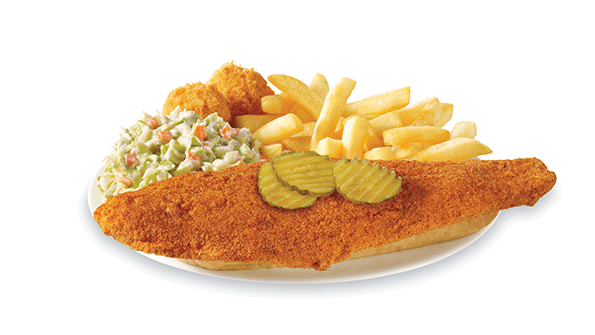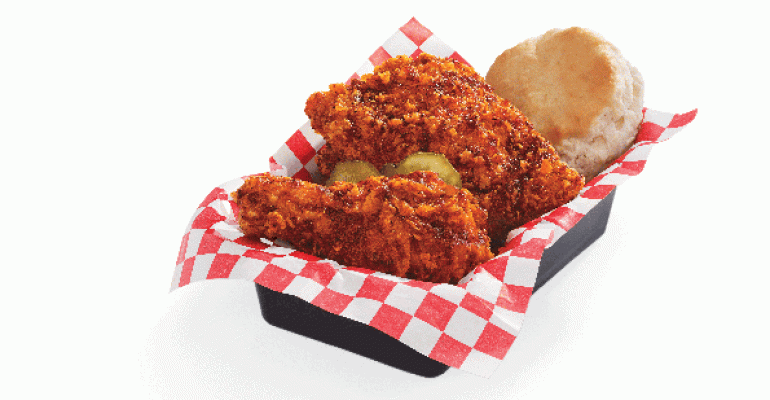
A humble dish from Tennessee has become the hottest trend in fried food.
Created out of anger but thriving on the current crazes for fried chicken, spicy food and dishes with compelling backstories, Nashville hot chicken has swept the nation, inspiring regional variations, chef-inspired touches, and experimentation with proteins ranging from pig ears to rabbit feet. With KFC’s introduction of the dish as a limited-time offer earlier this year, hot chicken has clearly gone mainstream.
Although Nashville hot chicken has been trending for awhile, a Google Trends search shows that it really took off when Louisville, Ky.-based chicken giant KFC introduced it as a limited-time offer at its 4,270 locations nationwide from Jan. 18 through April 3.
“We were challenged by our president to come up with a signature spicy chicken,” KFC head chef Bob Das said. “We’ve known about [Nashville] hot chicken for some time,” and he liked the idea of bringing it to a wider audience.
“It did exceptionally well,” chief marketing officer Kevin Hochman said, although he declined to offer specifics. “When you look at the comments and the responses, people just did not want us to make this a limited-time offer.”
“It’s definitely a destination flavor,” he added.
Hochman added that, although hot chicken has been big in foodie circles for a few years now, “It did not have broad awareness for the masses [until we introduced it], and that’s something we’re exceptionally proud of.”

“Hot chicken has really gone nuts,” said Atlanta chef Linton Hopkins, CEO of Resurgens Hospitality Group, which operates eight restaurants, including Hop’s Chicken. Hop’s Chicken opened last September in Ponce City Market and serves fried chicken by the piece in sauces such as black pepper gravy, buttermilk ranch, honey mustard and a hot sauce.
The hot sauce is inspired by Prince’s Hot Chicken Shack in Nashville, which is credited for inventing the dish some 80 years ago.
As the restaurant’s owner, Andre Prince, has related the story on many occasions, the chicken was invented by the girlfriend of her great uncle, Thornton Prince, as a punishment for his infidelity. One morning at breakfast she doused his fried chicken in a blisteringly hot sludge of lard and cayenne, and to her dismay, he loved it.
Nashville hot chicken is traditionally made by coating fried chicken in a cayenne-heavy, oil-based paste and serving it with white bread and pickles.
“This wasn’t some fancy, chef-driven artisan phenomenon,” Hopkins said. “It was really about what you could find at, say, a Piggly Wiggly [supermarket] in the American south.”
Hopkins said the spiciest version of Prince’s is so hot that it’s “almost unbearable,” so, on a scale of 1 to 10 with 10 being the spiciest, his is around 5 to 7.
But cayenne pepper, he noted, comes on quickly and then goes away, unlike peppers such as habanero that linger and even build over time. “It’s a bright slap in the face that then cools down with waves,” he said of cayenne.
He added that the chicken meat also has a cooling effect, and for that reason he prefers the breast for hot chicken.
“Wings are good, but you want a high ratio of hot, seasoned, moist chicken meat,” he said.
He brines the chicken and then lets it marinate in buttermilk. He follows that with a coating of flour, salt, pepper, cayenne and a little paprika.
“You really want to get most of the flour off of there,” he said.
Then, like at many quick-service chains, he pressure fries it at 245° to 250° Fahrenheit.
“We learned a lot from the world of quick-service chicken,” he said.
The classic hot chicken sauce is a combination of cayenne and paprika mixed with the frying oil. But Hopkins also adds garlic, onion powder and some granulated sugar. He mixes that into a paste with lard and brushes it on the chicken when it comes out of the fryer. He charges $1 per wing, $2 for a drumstick, $3 for a thigh and $5 for a breast.
Hot chicken sweeps the nation

Celebrity chef Carla Hall, a native of Nashville, recently brought hot chicken to Brooklyn, N.Y., with the opening of Carla Hall’s Southern Kitchen, where meals, including two pieces of chicken or three tenders, two side dishes and a slice of bread are priced at $13.25 to $15.50.
She said much of what she does with her fried chicken is simply how her grandmothers made it, but she has changed the frying medium. She uses rice bran oil.
“It’s lighter, [the chicken] actually absorbs less oil and it lasts longer,” she said. “We get about 20 fries out of it, and then we filter it.
“The taste is really light and the skin is really crispy. It’s a little more expensive, but I think it’s worth it.”
She dry-brines the chicken with vinegar powder, paprika and garlic powder. She dredges it in flour seasoned with some of that brine powder, and then fries it.
Unlike many fried chicken makers, she doesn’t soak it in buttermilk, which she said saves time and money, “and it’s also the way my grandmothers used to do it.”

Hall’s hot sauce comes in five levels, from a sweet Hoot & Honey and medium Hoot to a blistery Boomshakalaka, and she uses different chiles, tempered with fruit powders, for different heat levels. Her spicy Hootie Hot is made with a blend of habanero peppers and pineapple powder. Her spicier Hoot-N-Nannie is a combination of ghost peppers and mango powder, and Boomshakalaka blends Carolina reaper peppers, Scotch bonnets, cayenne and Thai bird pepper with banana powder.
“I ran the gamut [of chiles] and I knew I wanted the pepper to stand out. That would be my part — to eat and honor the peppers,” Hall said.
Rather than lard, she uses canola oil as the base for her hot sauces.
Kyle Anderson, the chef of Moxie, the Restaurant, in Cleveland, also uses canola oil for his hot chicken, which he offered as a special for a week in July for $21.50 with two sides. Although he originally used lard and thought it tasted better that way, he decided to use vegetable oil so it would have broader appeal. He mixed it with a blend of sweet paprika, smoked paprika, cayenne, black pepper, granulated garlic, kosher salt and brown sugar. He served it over super-spongy challah.
“We sold a ton of them,” he said.
Jason Starnes uses a more obvious fat as the base of his sauce at South City Kitchen Buckhead in Atlanta: chicken fat.
He makes a hot chicken knife-and-fork sandwich that he serves on toasted focaccia and which also includes Alabama white barbecue sauce, which is made with mayonnaise, vinegar and a heavy dose of black pepper. It’s $12.
His hot sauce is based on his house hot sauce, which is fermented red jalapeño with a little habanero as well as some cayenne, sweet dark chile powder and vinegar. He adds that to the chicken fat along with more sweet chile, black pepper and cayenne, “because you can’t have hot chicken without cayenne,” he said.
Nashville-based fish chain Captain D’s Seafood Kitchen introduced Nashville Hot Fish to locations in Nashville, St. Louis and Jacksonville, Fla., last fall, and then rolled out as a limited-time offer at all of its 510 locations this past spring. It was topped with pickles and served with two sides and hush puppies for $4.99.
It proved popular enough that Jason Henderson, the chain’s vice president of product innovation, said they’ll likely bring it back, especially since he and his team developed an easy way to prepare it.
Instead of preparing a hot oil-based sauce, they developed a dry coating that can be shaken onto his fried fish and then uses an atomizer to spritz it with oil.
Henderson said the oil keeps the spice coating on the fish and “kind of becomes one with the breading system. It gives it that authentic kind of oil-and-seasoning mouthfeel.”
He said that, although Captain D’s customers haven’t traditionally taken to spicy food, they enjoyed this one. Franchisees have the option of keeping the hot fish on the menu, and they also keep the spice mix around in case guests want it on anything else, such as chicken tenders, shrimp or grilled fish.
Innovating hot chicken

Yard House, a casual-dining chain based in Irvine, Calif., introduced hot chicken to its 66 locations last year.
“For me it was personal,” said executive chef Carlito Jocson, who moved his daughter to Nashville three years ago and stayed in a hotel across the street from long-standing hot chicken shack Hattie B’s.
“I must have eaten it every day for a week,” before he left Nashville, he said.
Instead of white bread, which is traditionally used to absorb excess hot sauce, Jocson serves it with equally absorbent potato pancakes along with ranch dressing and honey habanero sauce. For a chef-inspired touch, he tops the chicken with fried sage and sells it for $16.65
In July [this month], Yard House extended its hot chicken options by adding a sandwich for $12.65.
“Our job was: How are we going to do a chicken sandwich? I mean, last year was undoubtedly the year of the fried chicken sandwich,” so he had to do something new, he said.
He decided he wanted something creamy, and he wanted crunch. For creaminess, he made an aged white Cheddar cheese spread made of cheese, mayonnaise, onion powder, garlic powder and Tabasco.
For crunch, he made a red and green cabbage slaw doused in honey habanero hot sauce, “so you got this contrast of spicy and sweet and this creamy sharp Cheddar on the bottom.”
He serves pickles on the side.
He said in the first week, the sandwich tripled expectations.
In Nashville, hot chicken traditionally has been isolated to select long-standing unpretentious shacks, but with its popularity have come new iterations of it.
In that city’s Lockeland Table, chef Hal Holden-Bache makes Nashville hot crispy pig ears.
“I am slightly addicted to the hot chicken flavor [but] I thought, well, why do a version of the same thing that everyone else is doing?”
So he braises the ears for about eight hours, cools them, juliennes them, fries them and then tosses them with “the hot chicken sludge,” which he makes with bacon fat.
He serves it hot chicken style with white bread and pickles, as well as coleslaw for $10.
At Craft & Vine in Augusta, Ga., chef Sean Wight makes braised and fried rabbit “wings,” out of the forelegs of the animals, which he sells for $13. The sauce has vinegar, onion, salt and water as well as cayenne, and then is whipped with butter, so in some ways it’s more of a Buffalo sauce, but he also does Nashville hot oysters for around $15, which are breaded in flour with espelette and cayenne pepper and then tossed in hot sauce.
“When we make it for staff meal it’ll melt your face off, but you have to temper it for your customers,” he said.
Contact Bret Thorn at [email protected]
Follow him on Twitter: @foodwriterdiary

